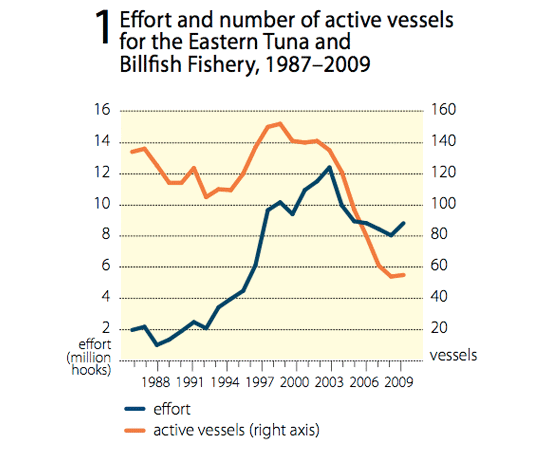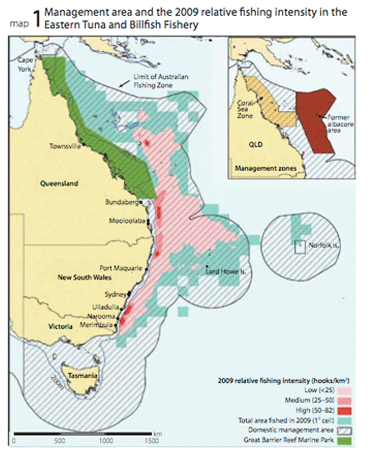Overview of the fishery
The area of the Eastern Tuna and Billfish Fishery (ETBF) extends from Cape York to the Victoria– South Australia border, including waters around Tasmania (map 1).
The major ports for the fishery are Cairns, Mooloolaba, Southport, Coffs Harbour, Mackay, Sydney and Bermagui. In 2008– 09, the gross value of production of the ETBF was $38.9 million, making it the fourth highest valued Commonwealth fishery (excluding the SESSF overall; ABARE–BRS 2010). There were 55 active longline vessels in 2009 (figure 1), which caught a total of 6086 t, of which 5311 t was the five main species (figure 2). The target species for the ETBF are albacore tuna, bigeye tuna, yellowfin tuna and swordfish (see appendix A for species names).
Fish are mainly caught on pelagic longline; there is also a minor line component including trolling, pole-and-line and handline. Operators in the ETBF also land a number of by-product species including striped marlin, black oilfish (also known as escolar), mahi mahi (also known as dolphinfish), moonfish, rudderfish and wahoo.

The target species of the ETBF are highly migratory and are part of broader western and central Pacific Ocean stocks which extend into the high seas and into the Economic Exclusive Zones (EEZ) of other nations. The broader stocks are managed by the Western and Central Pacific Fisheries Commission, of which Australia is a member.
Fishing activity in the ETBF is affected by the availability of target species, market factors, changes in the exchange rate and costs such as fuel prices. Effort for the fishery fell from a peak of 12.40 million hooks (135 vessels— vessel numbers peaked at 152 in 1999) in 2003 to 8.82 million hooks (55 vessels) in 2009 (figure 1). This was a result of management changes and external factors such as the strength of the Australian dollar, increased operating costs, implementation of a total allowable catch (TAC) for swordfish and the surrender of fishing permits under the structural adjustment component of the Australian Government’s Securing Our Fishing Future package (Wilson et al. 2010).
During the mid-1990s, access to swordfish markets in the United States resulted in many fishers moving to southern Queensland ports to target swordfish (figure 2). In 2006, ETBF fishers began to use deep-setting techniques to target albacore in response to reduced swordfish availability, high operating costs and poor market demand. In 2007, targeting was redirected to bigeye tuna (Wilson et al. 2010).

Gamefishing off the east coast tends to be offshore of key ports such as Cairns, Mooloolaba, Sydney, Brisbane, Gold Coast, Port Stephens, Coffs Harbour, Wollongong, Batemans Bay and Bermagui (Moore et al. 2007). Fishing methods used include trolling (live baits, dead baits and artificial lures), live and dead drifting bait and spinning (casting and retrieving artificial lures). Primary target species include black marlin, striped marlin, blue marlin, yellowfin tuna, wahoo, sailfish, albacore tuna, swordfish, tiger shark, hammerhead sharks and various whaler sharks (Moore et al. 2007).

Potential effects of climate change on target species
The El Niño-Southern Oscillation (or ENSO) describe the oscillation between the El Niño phase and the La Niña phase: ‘El Niño’ refers to the extensive warming of the central and eastern Pacific that leads to a major shift in weather patterns across the Pacific, while ‘La Niña’ refers to the cooling of the same area. Hobday et al. (2008) identified changes in temperature, ENSO and the East Australian Current as ‘the main drivers of climate change impacts in the pelagic realm’. Oceanographic features such as temperature, oxygen concentrations and depth affect the distribution and catch rates of tuna species throughout the world (Brill 1994, Song et al. 2009).
ENSO events also appear to be a factor in determining distributions of tuna and billfish (Lehodey et al. 1997, Torres-Orozco et al. 2006). It is also thought that ENSO events influence the migration of tuna into Australian waters (Kompas et al. 2009). Recruitment for south Pacific albacore is enhanced during La Niña events. The effects of climate change on ENSO events and how any changes may affect Australia, are not clear; however, it is believed that the future climate will be ‘El Niño’ like (CSIRO and the Bureau of Meteorology 2007, Hobday et al. 2008, Holbrook et al. 2009).
The East Australian Current has an important influence on the seasonal distribution of tuna and billfish species off eastern Australia (Kailola et al. 1993), taking warmer water from the Coral Sea southwards to the cooler Tasman Sea. Under climate change scenarios, the current is expected to strengthen and travel further south, perhaps as far south as Tasmania (Hobday et al. 2008). This may change where key species occur and potentially expand their distributions southwards. The distribution of target species under climate change scenarios will also depend on the availability of their prey.
Increased intensity and frequency of storms may affect fishing infrastructure, as well as when and where fishers go to sea. Tropical cyclones in north-eastern Queensland mostly occur between Port Douglas and Maryborough, where the ETBF has ports. If storms increased in frequency or intensity, there could be fewer fishing days available to fishers during the year. In some locations, recreational charter fishing operations could also be affected by more frequent extreme events (Vieira and Newton 2008). Storms also enhance upwellings (Fujii and Yamanaka 2008), which are important foraging grounds for tuna species off southern Australia (Hobday et al. 2009).
Challenges and opportunities
Commercial fishers in the ETBF, who already face considerable variability in the fishery, switch between target species and methods as availability and market conditions change. They vary the location of their fishing activities, based on a number of environmental variables such as sea surface temperature.
If the East Australian Current strengthens and travels further south, it may increase the availability of large pelagic species to Australian commercial and recreational fishers in areas where these species were formerly absent or in low abundance.
If there was an eastward shift in the distribution of tuna and billfish, or if the distance fishers had to travel from port increases, fishing may be less economically viable from particular ports due to decreased access and increased costs. On the other hand, if there was a westward shift in distribution, fishing costs may decrease. Fuel is one of the major costs for both the commercial and recreation fishery. In 2008–09, fuel accounted for approximately 14 per cent of the cash costs for the average vessel in the ETBF (Perks and Vieira 2010).
Multi-species, opportunistic fisheries such as the ETBF are likely to be more resilient to climate change than fisheries that rely on a single species. This is because fishers can switch between target and by-product species as their availability and distribution changes.
Changes to the East Australian Current may also affect the distribution of southern bluefin tuna off eastern Australia. The expansion of the current will likely result in the suitable habitat for yellowfin and southern bluefin tuna moving further south (Hartog et al. 2011). This might result in fishers who target yellowfin tuna but do not hold sufficient southern bluefin tuna being excluded from an extended fishing area.
Climate change may also affect catch quality and catch rates. Fish quality begins to deteriorate immediately from the time of death. Temperature is an important factor in determining the rate of deterioration of fish (Groenewold and Fonds 2000). The increased water temperatures may lead to the quality of catch deteriorating more rapidly. Soak times may need to be adjusted to account for changes in sea surface temperature.
A comparison of average soak times between the northern ETBF (above 20°S) and the southern ETBF (below 20°S) showed that soak times are shorter in the north of the fishery (13.5 hours versus 19 hours). However, soak times also have an effect on catch rates of species. For example, catch rates of sharks and billfish increased with soaking time, while catches of skipjack decreased (Ward et al. 2004).
Issues for policy and management consideration
At an international scale, changes to the distribution of these stocks may increase access for some nations as stocks move into their Exclusive Economic Zones (EEZs), while moving out of other EEZs and decreasing availability to those nations. This may have serious implications for some small island nations in the Pacific Ocean who depend heavily on these stocks for food security and their economies. The contribution of fishing to the gross domestic product (GDP) can also be substantial. For example, in 2006, capture fishing contributed 62.8 and 57.7 per cent to the GDPs of the Marshall Islands and Kiribati, respectively (Lymer et al. 2008).
Changes to the availability of target stocks on the high seas may also lead to an increase in fishing, both reported and illegal, unreported and unregulated (IUU). An increase in high seas fishing (both reported and IUU) may affect already depleted stocks in the region such as those of bigeye tuna.
At a local scale, changes in the distribution of target stocks may affect current spatial management arrangements such as marine protected areas and areas with restricted access (i.e. the Coral Sea Zone). These areas are typically based on historical fishing activities and do not necessarily account for changes in future fishing patterns.
Changes in distribution of target species may also affect recreational fishers’ access to these species and increase interactions between recreational and commercial fishers, and management arrangements.
In order for fishers to adapt to climate change, fisheries management may need to provide flexibility for fishers to change their behaviour while ensuring stocks are not at risk and are maintained at an appropriate biomass level.
Closures, which are based on historical patterns in fishing activities, might limit the flexibility of ETBF fishers to move into new areas, if the distribution of species changes.
Increasing access to markets for by-product species such as mahi mahi and moonfish may provide a buffer for businesses during increased uncertainty and times when target species may not be available.
The Commonwealth Fisheries Harvest Strategy Policy accounts for climate-induced changes through the use of the ‘exceptional circumstances’ category. These circumstances, invoked under pre-agreed criteria, would result in an over-ride of the management advice arising from the straightforward application of the harvest strategy, for example, if there has been a change in the ecological environment of the fishery unrelated to impacts of fishing. However, there may be benefits in addressing changes due to climate change (as well as other environmental impacts) in the individual fisheries harvest strategy framework.

